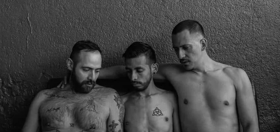
New York’s absolutely, positively buzzing with Fashion Week excitement. To prepare for all the happenings, we had a little sit down with Valerie Steele. If you’re not familiar with Steele, you should be.
As a thinker, Steele’s elevated fashion from the simply material to the theoretical. Her journal, Fashion Theory, exploded the closet doors to challenge academics and fashionistas alike. Now in its tenth year, FT‘s just launched Russian and Brazilian edition. In addition to her ever-growing intellectual influence, Steele’s published a number of books on fashion, including the titilating Fetish.
Steele’s currently the curator for the Fashion Institute of Technology’s Museum, which has turned its eye to the ever-present, seemingly contradictory concept of “luxury”. Steele took some time from planning the next show – Gothic Dark Glamour – to chat about the connection between queer and fashion theories, who decides what we’ll wear and how Calvin Klein shined a light on male vanity.
Read all about it, after the jump.
Andrew Belonsky: Why fashion? What’s the interest for you?
How about we take this to the next level?
Our newsletter is like a refreshing cocktail (or mocktail) of LGBTQ+ entertainment and pop culture, served up with a side of eye-candy.
Valerie Steele: I went to get my doctorate at Yale in European Cultural and Intellectual History. One day, I had an epiphany – a friend of mine had given a talk about two contrasting feminist and non-feminist interpretations of the corset and a light bulb went on and I thought, “Oh my God, fashion is part of cultural history. I can study fashion professionally instead of just being obsessed with it personally!” I had always loved fashion, but it never occurred to me in a million years that that was a legitimate, scholarly topic. And, indeed, it wasn’t. Most of my professors treated it as an unspeakable, stupid topic. Frankly, I was just intrigued by the fact that so many academics thought it was a despicable topic. That anti-fashion sentiment – that it was bourgeois and sexist and conformist – just made me more interested in it.
AB: Do you think it’s bourgeois and sexist?
VS: No. I mean, there was a very academic perspective on fashion that held sway for a long time. That only started to change with the rise of queer studies, when, for the first time, you were getting academics who were looking at fashion in terms of performativity – expressing deviant identities. Then, suddenly, from this lock step, old leftie, old line feminist “fashion is bad,” you got a much more nuanced “fashion could be good, it could be bad, it could be an amoral phenomenon,” but it [wasn’t] just a knee-jerk, negative response.
AB: Can you explore more the relationship between fashion and queer theories? Aside from the performativity, there’s – obviously you’re performing your identity – but people were turned off by both disciplines because they both explicitly push against conformativity. Both queer theory and fashion theory stress the importance of the individual, going against the grain. It seems to me – just from my experience in academia – that many people aren’t as willing to think critically about things that people do to physically remove themselves from the mainstream.
VS: I think that queer theory is a much more coherent theory, although I chose fashion theory as the topic for my journal. That was a deliberate provocation, because there isn’t any fashion theory – not like there’s queer theory or Marxist theories of history. Fashion theory doesn’t exist, but it’s something that I thought we should be reaching towards a more theoretically informed understanding of fashion, rather than just the purely empirical costume history. We needed to start asking questions about how fashion functioned either for individuals or for cultures. I think, in a way, one of the connections between queer theory and fashion theory is it has to do with the embodied self. I’m trying to think of the definition of fashion, even though I thought of it….
AB: “The cultural construction of the embodied identity.”
VS: Yes! Bringing the body back into the picture has always been central to how I’ve thought about fashion, because fashion – unlike art or furniture design – is first and foremost about the body. That’s also true about how queer theory developed. It’s not just the individual. It’s the individual who’s also a body. I think academics steered away from fashion in part because it seemed too material. It’s physical. It’s about things and bodies. It’s not really about the life of the mind. Queer theory also said you have to embody the theory, because it’s bodies that have sex and have sexual identity.
AB: The underwear industry’s something like 3 billion dollars a year. It’s really crazy. What do you think about that? Thinking about fashion – people wear fashion to show themselves externally, yet we have the growth of this business, particularly among men, where you don’t see anything.
VS: Well, yes, but for more than 100 years, the women’s fashion press has been talking about how fashion is not just a way of communicating with other people, but it’s also a way of making yourself feel particular ways. What we saw, I think especially with the Calvin Klein underwear, is the acceptance by increasing numbers of men that they actually did have a relationship with their body and that clothing could enhance feelings of masculinity and sexual potency. Men were becoming more willing to think of themselves as sexual objects. They would look at the famous Bruce Weber advertisements of Calvin Klein – I think that’s what started the whole trend of men investing in particular kinds of underpants. That was the kind of clothing that was most intimately associated with masculine sexuality.
AB: Somebody was telling me once that it’s not so much the designers who set the tone for a season, but the fabric dealers, because they only bring x amount of purple linen or red leather. They’re actually the ones who dictate what we’ll be wearing.
VS: Actually, they don’t dictate it, either. The problem of thinking in terms of some commercial category of people who dictate the fashions is false. Actually, there’s this one great book that I can’t recommend enough – A Matter of Taste by Stanley Lieberson. It’s about fashion and all kinds of phenomenon – why fashion changes, not particularly clothes, but it applies to clothes, too. The shifts in fashion really are coming from broader cultural taste levels. People start moving toward a certain sensibility. Sometimes these shifts are tied to really big socioeconomic shifts, like the rise of anti-establishment feeling in the 1960s and 70s. Sometimes there are more short-term, trendy things that will move along the surface. I think the basic impetus behind change comes from three levels. On the one hand there’s big, socioeconomic changes, which have a gradual and usually indirect influence on fashion. Then there are the professional, craft elements: the designers, the editors, the textile manufacturers who do have an influence in that middle range, but they’re also drawing on the wider culture. For example, the textile producers, like the designers and the editors, are looking at what the kids in Union Square are wearing. They’re trying to pick up – what are things that they should be factoring back into what they manufacture. And then there’s the level of individuals. There are influential individuals ranging from Madonna to Marc Jacobs who play a role in titling fashions one way or another, but often those individuals are responding to things in the culture.
AB: Shifting gears, I want to talk about the Goth Show.
VS: Oh, yes! I think this is going to be the best show we’ve ever done, even better than the corset or London fashion. It will be next year, fall ’08. It’s called “Gothic Dark Glamour”. It’s looking at the Gothic sensibility – the Gothic taste: exactly what we were talking about. There are people who gravitate toward pastels. There are people who gravitate toward black. There are people are attracted to things that have a dark side. The influence of Gothic style on fashion – a lot of designers have been working in this genre –tend to draw the visual vocabulary from the Goth subculture, which emerged in the late 70s and early 80s. That Goth subculture was also looking back to a whole strain of dark romanticism that runs from the late-18th century through the 20th century to the present. I’ve been trying to do a genealogy and trace back in time and see why was it that people in the Goth movement in the 80s were attracted to Victoriana. The Victorians didn’t think there was anything macabre or mysterious about their corsets or their habit of wearing mourning dress, but by the late-20th century, Goths really thought that said something about being different from the pastel-colored conventional world. They looked back to the past and made this leap back into Victorian fashion, dug it up and mixed it in and created out of that something that had a Gothic sensibility. There’s no one Gothic fashion, but different fashions become Gothicized at different periods. People want to make a statement about being different, being deviant, being transgressive. A lot of the original Goth movement in the 80s – they were drawing on breaking down certain boundaries between being male and female. The death look was very transgressive. Not only does it go back to fears of death and keeping death at a distance, but also it reacts against all of the major cultural emphasis on looking healthy and beautiful. It’s an alternative idea of beauty.
AB: You’ve been working on The Luxury Show – when is that up until?
VS: That is up until November 10th.
AB: Why luxury?
VS: Well, what could be more timely than luxury? It used to be exclusive and now there are all kinds of accessible luxuries that are being proposed, which means it’s no longer luxury, if people can get access to it. It seemed like an interesting topic to look at 250 years of luxury through fashion. The move toward mass luxury, how you create new luxury: American companies versus old European companies. What does luxury mean to people? I want people to come into the show and think about what their attitude is about luxury. Is it a question of sensual pleasure or is it a question of social status?

















